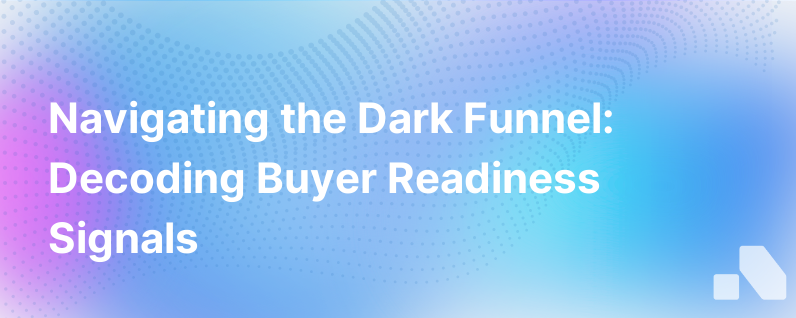
Navigating the waters of B2B sales is a nuanced art, particularly when it comes to understanding the subtleties of buyer readiness. Unlike traditional sales funnels where prospective buyer behaviors are visible and traceable, the dark funnel is elusive, yet it's where much of the buying journey happens—in social conversations, peer-to-peer interactions, and content engagement that's invisible to marketing and sales teams. Unraveling the signals within this shadow realm can transform your ability to connect with buyers precisely when they're ready to engage. However, deciphering buyer readiness in the dark funnel requires a combination of insight, strategy, and technology.
Understanding the Dark Funnel
The dark funnel represents the part of the customer's journey that lacks transparency for sales and marketing teams. Typically, a significant amount of pre-purchase research and decision-making happens here, unbeknownst to you. Prospects might be consuming content, engaging with their networks, or considering reviews without showing direct interest in your brand yet. The challenge, however, is that traditional analytics and tracking methods don't illuminate these activities. Therefore, businesses must adapt by recognizing signals and patterns that indicate where a prospect is in their buying journey.
Signals of Buyer Readiness in the Dark Funnel
Buyer readiness signals in the dark funnel can come in various forms. From content interaction patterns to off-handed mentions on social media, every potential buyer leaves a digital footprint. Here's what to look for:
- Content Engagement: While direct interactions are often easy to track, indirect engagements such as download rates, time spent on particular pieces of content, and social shares can be signals of interest.
- Social Listening: Monitoring mentions of your brand, product, or industry-related topics can reveal interest levels. Utilize social listening tools to identify and analyze these conversations.
- Peer-to-Peer Discussion Involvement: Buyers often seek advice from their peers. While these discussions are harder to track, tools exist that can monitor certain platforms and forums for mentions of related topics.
- Intent Data Usage: Leveraging intent data can provide insights into which accounts are actively researching topics relevant to your products or services.
- Email Engagement: Look beyond opens and click-through rates; deep diving into forward rates and print rates can also serve as indicators of engagement and readiness.
- Surge in Activity: A sudden spike in engagement from a particular account or region can signal a growing interest or a pain point that is becoming acute.
Strategies for Uncovering Buyer Readiness
To better understand buyer readiness, consider implementing the following strategies:
- Incorporate Predictive Analytics: Deploy predictive analytics tools that use AI to process massive amounts of data, revealing patterns that indicate buyer behavior in the dark funnel.
- Invest in Account-Based Platform Solutions: Account-based platforms allow you to personalize your approach by tapping into extensive databases that reveal actionable insights about your target accounts.
- Implement Advanced CRM Techniques: Ensure your CRM is equipped with tools that can integrate with other systems to track indirect interactions.
- Develop Robust Content Strategies: Create content designed to nurture prospects at different stages of readiness and track how this content is consumed and shared.
- Foster a Culture of Social Selling: Encourage and train your sales team to engage on social media, increasing the chances of intercepting and interpreting dark funnel signals.
- Perform Regular Data Analysis: Consistently analyzing your data can uncover trends and patterns that speak to buyer readiness even without explicit signals.
Leveraging Technology to Illuminate the Dark Funnel
Advancements in technology have made it possible to shed light on the dark funnel. Implementing tools that help decipher buyer signals is key:
- Intent Data Platforms: Use platforms like Bombora or 6sense to identify when prospects are in research mode.
- Social Listening Tools: Tools like Brandwatch or Mention can help you track brand-related discussions across the web.
- Engagement Analytics: Platforms like PathFactory or Google Analytics can give insight into how prospects interact with your content.
Case Study: Turning Signals into Actions
A perfect illustration of reading buyer readiness signals in the dark funnel would be using engagement analytics. A software company observed through its analytics platform that there was a surge in traffic from a particular account mainly focusing on articles about scalability issues. The sales team, prompted by this insight, reached out to the prospect with a webinar invite that addressed those challenges. This proactive approach, prompted by dark funnel signals, led to a fruitful conversation that would have been missed by adhering strictly to conventional funnel metrics.
Wrapping Up
Navigating the dark funnel successfully begins with acknowledging its existence and the pivotal role it plays in modern B2B buying processes. By acknowledging the limitations of traditional tracking methods and leveraging technology to interpret signals, you can connect with buyers at the most opportune moments.
In conclusion, understanding and acting on dark funnel buyer readiness signals is a complex but rewarding endeavor. It requires a commitment to analytics, a willingness to invest in the right technology, and an adaptability to new sales paradigms. For businesses ready to embrace these challenges, the rewards are increased alignment with customer needs and a more efficiently targeted sales process.
And for businesses looking to take it to the next level, platforms like Aomni can provide real-time, AI-driven insights and analytics, enabling you to make informed decisions and strategies based on buyer readiness indicators within the dark funnel.